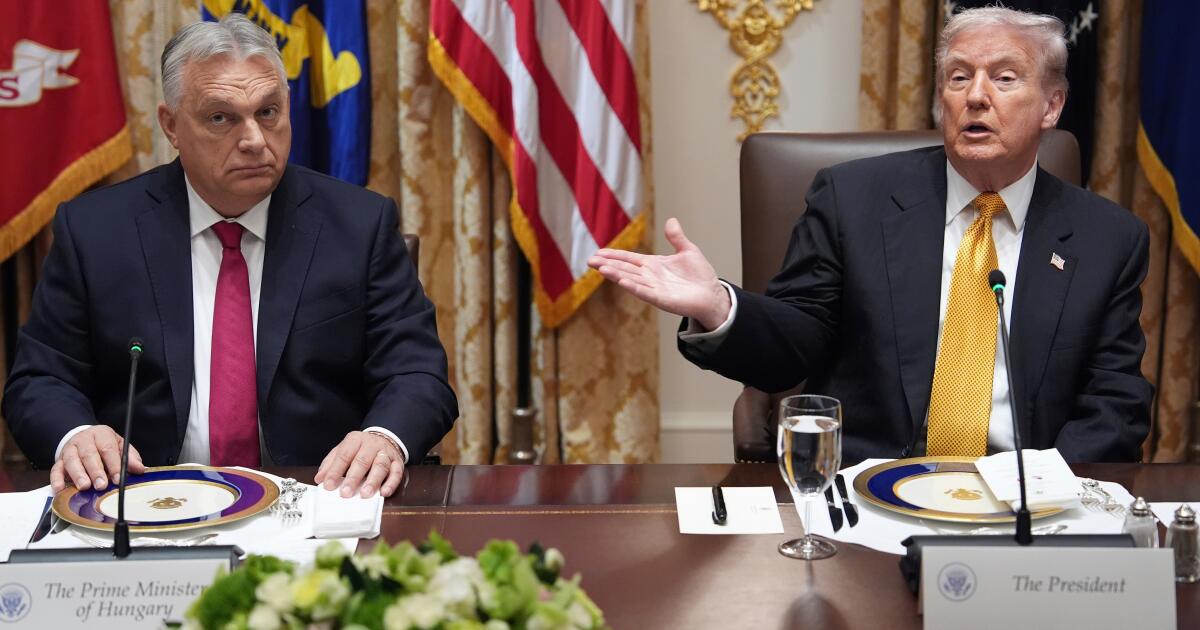Trump weighs Hungary’s request for exemption from Russian energy sanctions
WASHINGTON — President Trump said on Friday he’s considering granting Hungary an exemption from U.S. sanctions on Russian energy as he sat down with Hungarian Prime Minister Viktor Orbán at the White House. “We’re looking at it because its very difficult for him to get the oil and gas from other areas,” Trump said.
Orbán said it’s a “vital” issue for his landlocked country, and said he planned to discuss with Trump the “consequences for the Hungarian people” if the sanctions took effect.
In comments on Friday, Orbán said he would present Trump with several “suggestions” for implementing an exemption.
“I’m not asking for some kind of gift from the Americans or some kind of unusual thing. I am simply asking for the realization that the sanctions recently imposed on Russian energy puts certain countries like Hungary, which do not have access to the sea, in an impossible situation,” Orbán said on state radio. “I’m going to ask the president to acknowledge that.”
A large delegation of cabinet members, business leaders and numerous right-wing political influencers with close connections to Hungary’s government accompanied Orbán to Washington. The delegation rented a 220-passenger commercial jet from Hungarian carrier Wizz Air for the journey.
Prior to Orbán’s arrival on Thursday, a bipartisan group of U.S. senators introduced a resolution calling on Hungary to end its dependence on Russian energy.
The resolution was co-signed by 10 senators including Republicans Mitch McConnell of Kentucky, Thom Tillis of North Carolina and Chuck Grassley of Iowa, as well as Democrats Jeanne Shaheen of New Hampshire and Chris Coons of Delaware. It “expresses concern that Hungary has shown no sign of reducing its dependence on Russian fossil fuels,” and urges Budapest to adhere to a European Union plan to cease all Russian energy imports into the bloc by the end of 2027.
“Europe has made extraordinary progress cutting its energy ties with Moscow, but Hungary’s actions continue to undermine collective security and embolden the Kremlin,” Shaheen wrote in a statement. The resolution, she continued, “sends a clear message that when it comes to buying Russian energy, all allies should be held to the same standard, and that includes Hungary.”
On Friday, Hungarian Foreign Minister Péter Szijjártó said in Washington that he will sign a bilateral nuclear energy cooperation agreement with U.S. Secretary of State Marco Rubio, according to Hungarian state news agency MTI.
The deal will involve Hungary’s first-ever purchases of American nuclear fuel, which it currently buys from Russia, and introduce U.S. technology for the on-site storage of spent fuel at Hungary’s Paks nuclear plant. The agreement will also include cooperation on small modular reactors.
After arriving in Washington, Orbán and some of his top officials met with Eduardo Bolsonaro, the son of former Brazilian President Jair Bolsonaro, who in September was sentenced to 27 years in prison for plotting a coup after an election loss. Orbán posted on social media: “We stand firmly with the Bolsonaros in these challenging times — friends and allies who never give up. Keep fighting: political witch-hunts have no place in democracy, truth and justice must prevail!”
Megerian and Spike write for the Associated Press. Spike reported from Budapest
